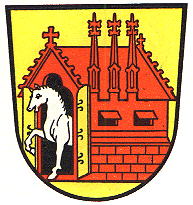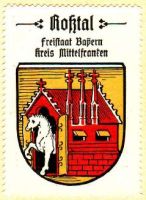Rosstal: Difference between revisions
Jump to navigation
Jump to search
Knorrepoes (talk | contribs) m (Text replacement - "{{de}}" to "") |
Knorrepoes (talk | contribs) No edit summary |
||
| Line 1: | Line 1: | ||
{| class="wikitable" | |||
|- style="vertical-align:top;" | |||
|[[File:rosstal.jpg|center|350 px|alt=Wappen von {{PAGENAME}}/Arms (crest) of {{PAGENAME}}]] | |||
| | |||
'''Country''' : Germany [[File:germany.jpg|60 px|right]]<br><br><br> | |||
'''State''' : [[Bayern]][[File:Bayern.jpg|60 px|right]]<br><br><br> | |||
'''District (Kreis)''' : [[Fürth (kreis)|Fürth]][[File:furth.kreis.jpg|60 px|right]]<br><br><br> | |||
'''Additions''':<br> | |||
* 1978 Buchschwabach | |||
* 1978 Großweismannsdorf | |||
* 1978 [[Weinzierlein]] (partly) | |||
* 1978 [[Weitersdorf]] | |||
{{#display_map:51.3395,12.37525|width=250|height=250|zoom=7}} | |||
|} | |||
{| class="wikitable" | {| class="wikitable" | ||
| Line 13: | Line 19: | ||
|- | |- | ||
|'''German''' | |'''German''' | ||
| | | In Gold eine rote gotische Kirche mit Dachtürmchen, aus deren Tor ein silbernes Ross schreitet. | ||
In Gold eine rote gotische Kirche mit Dachtürmchen, aus deren Tor ein silbernes Ross schreitet. | |||
|- | |- | ||
|'''English''' | |'''English''' | ||
| Line 23: | Line 28: | ||
Rosstal received city rights in 1328, but the town did not develop into a proper city at the time. The oldest seal dates from 1501 and already shows a horse coming from a church. The arms are canting, Ross-Stall, or horse-stables, in which the stables were replaced by a church. There are no other seals known until 1819 and it shows, as did the mayor's chain from 1836, the above arms. Ever since the composition has remained the same, even though the size and shape of the individual elements has differed widely. | Rosstal received city rights in 1328, but the town did not develop into a proper city at the time. The oldest seal dates from 1501 and already shows a horse coming from a church. The arms are canting, Ross-Stall, or horse-stables, in which the stables were replaced by a church. There are no other seals known until 1819 and it shows, as did the mayor's chain from 1836, the above arms. Ever since the composition has remained the same, even though the size and shape of the individual elements has differed widely. | ||
<gallery widths=250px heights=200px perrow=0> | |||
File:rosstal.hagd.jpg|alt=Wappen von Rosstal/Arms (crest) of Rosstal|he arms by [[Otto Hupp|Hupp]] in the [[Kaffee Hag albums]] +/- 1925 | |||
| | File:Rosstalp.jpg|alt=Wappen von Rosstal/Arms (crest) of Rosstal|Postal cancellation | ||
</gallery> | |||
[[Civic Heraldry Literature - Germany|'''Literature''']]: Stadler, 1964-1971, 8 volumes. | [[Civic Heraldry Literature - Germany|'''Literature''']]: Stadler, 1964-1971, 8 volumes. | ||
Revision as of 05:43, 20 February 2023
|
Country : Germany State : Bayern District (Kreis) : Fürth Additions:
|
| German | In Gold eine rote gotische Kirche mit Dachtürmchen, aus deren Tor ein silbernes Ross schreitet. |
| English | No blazon/translation known. Please click here to send your (heraldic !) blazon or translation |
Origin/meaning
Rosstal received city rights in 1328, but the town did not develop into a proper city at the time. The oldest seal dates from 1501 and already shows a horse coming from a church. The arms are canting, Ross-Stall, or horse-stables, in which the stables were replaced by a church. There are no other seals known until 1819 and it shows, as did the mayor's chain from 1836, the above arms. Ever since the composition has remained the same, even though the size and shape of the individual elements has differed widely.
he arms by Hupp in the Kaffee Hag albums +/- 1925
Literature: Stadler, 1964-1971, 8 volumes.




